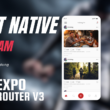Mục lục : Show
The release of Expo SDK 52 marks a significant step forward in the world of mobile app development. With a focus on improved performance, updated libraries, and enhanced architecture, Expo SDK 52 is designed to streamline the development process for React Native apps. However, with progress comes challenges, and developers must carefully navigate compatibility issues and debugging hurdles.
Expo SDK 52 Release Date and Beta Availability
Expo SDK 52 was officially released in October 2024, following a successful beta testing phase. This release introduced a variety of enhancements aimed at modernizing app development while ensuring compatibility with the latest iOS and Android platforms.
Key Features of Expo SDK 52
- New Architecture by Default
The most notable change is the adoption of a new architecture as the default for all new projects. This shift brings:- Faster performance and smoother app experiences.
- Better integration with React Native’s latest updates.
- Updated Libraries
- expo-camera: Enhanced APIs make it easier to use a camera in Expo, with improved stability and performance.
- expo-router: Developers can create modern, seamless navigation systems using the updated expo-router.
- expo-updates: The library now supports faster deployment and better offline capabilities.
- Tree Shaking for Smaller Apps
With expo-dev-client and the new tree-shaking capabilities, apps are now more optimized, removing unused code and reducing overall size. - Compatibility Improvements
- Minimum requirements: iOS 15.1 and Android SDK 24.
- Integration with React Native 0.76 for enhanced compatibility with third-party libraries.
- expo-doctor for Diagnostics
The expo-doctor tool helps developers diagnose and resolve configuration issues quickly, reducing downtime during development.
Challenges in Expo SDK 52
While the new features are exciting, there are some challenges developers should prepare for:
- Library Compatibility Issues
Certain libraries, like the now-removedexpo-barcode-scanner, require developers to find alternatives. - Debugging in React Native 0.76
The latest React Native version offers powerful tools but has introduced some debugging complexities that may slow down troubleshooting. - Higher Minimum Requirements
Apps must now support iOS 15.1+ and Android SDK 24+, potentially requiring updates to existing configurations.
Comparison with Previous Versions
| Feature | SDK 51 | SDK 52 |
|---|---|---|
| Default Architecture | Old | New |
| Tree Shaking | Not Available | Available |
| expo-camera | Basic functionality | Enhanced APIs and features |
| Platform Requirements | iOS 14.0+, Android SDK 21 | iOS 15.1+, Android SDK 24 |
| expo-router | Limited Features | Advanced and modern routing |
Tips for Upgrading to Expo SDK 52
- Test Libraries
Ensure all libraries used in your project are compatible with the new version. Tools like expo-doctor can help identify potential issues. - Update Configurations
Adjust yourexpo.jsonand related files to meet the updated platform requirements. - Utilize expo-dev-client
This tool ensures a smoother development and testing process when working with custom builds. - Leverage Documentation
Explore the official Expo documentation for detailed guidance on using new features like expo-router and expo-updates.
Conclusion
Expo SDK 52 is a powerful update that provides developers with tools to create faster, smaller, and more efficient React Native apps. However, its adoption requires careful preparation and a willingness to embrace new technologies. With tools like expo-doctor and libraries such as expo-camera and expo-router, developers are equipped to tackle the challenges of modern app development.
If you’re considering upgrading to Expo SDK 52, ensure your app meets the new requirements and is thoroughly tested before release. Share your experience with the update and let us know your thoughts in the comments below!


